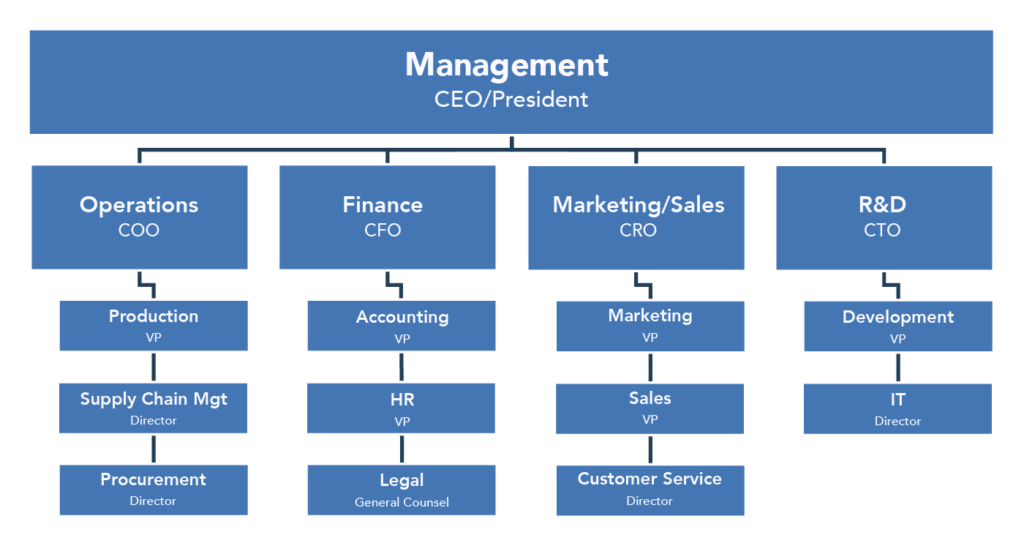

Just as different functions in the human body are performed and regulated by different organs, different functions within a business are performed and controlled by different parts of the business.
One of the reasons for separating business operations into functional areas is to allow each to operate within its area of expertise, thus building efficiency and effectiveness across the business as a whole. Functional areas in a business vary according to the nature of the market and the size of the business. For example, manufacturing companies like Nike and Apple have significant Research and Development (R&D) departments in order to stay in the lead in their respective business segments. On the other hand, retail companies may have no R&D functional area per se, but will be heavily invested in Operations areas surrounding Supply Chain Management.
In general, the key functional areas of a business are the following:
Each of these functional areas is represented in the following organization chart.

The primary role of managers in business is to supervise other people’s performance. Most management activities fall into the following categories:
Operations is where inputs, or factors of production, are converted to outputs, which are goods and services. Operations is the heart of a business—providing goods and services in a quantity and of a quality that meets the needs of the customers. Operations controls the supply chain, including procurement and logistics.
Marketing consists of all that a company does to identify customers’ needs and design products and services that meet those needs. The marketing function also includes promoting goods and services, determining how the goods and services will be delivered and developing a pricing strategy to capture market share while remaining competitive. In today’s technology-driven business environment, marketing is also responsible for building and overseeing a company’s Internet presence (e.g., the company website, blogs, social media campaigns, etc.). Today, social media marketing is one of the fastest growing sectors within the marketing function.
The goal of Sales is to close the revenue the company needs in order to operate profitably, especially in B2B businesses. Again, depending on the nature of the market and the company size, Sales functional areas can vary in structure and approach: inside/outside representation, vertical/horizontal focus, direct, etc. Sales works to exploit the leads created by Marketing and activities generated by the sales force itself.
The Finance function involves planning for, obtaining, and managing a company’s funds. Finance managers plan for both short-term and long-term financial capital needs and analyze the impact that borrowing will have on the financial well-being of the business. A company’s finance department answers questions about how funds should be raised (loans vs. stocks), the long-term cost of borrowing funds, and the implications of financing decisions for the long-term health of the business.
Accounting is a crucial part of the Finance functional area. Accountants provide managers with information needed to make decisions about the allocation of company resources. This area is ultimately responsible for accurately representing the financial transactions of a business to internal and external parties, government agencies, and owners/investors. Financial accountants are primarily responsible for the preparation of financial statements to help entities both inside and outside the organization assess the financial strength of the company. Managerial accountants provide information regarding costs, budgets, asset allocation, and performance appraisal for internal use by management for the purpose of decision-making.
Here is an example of the functional areas of a large technology manufacturing corporation and the key functions and people within.
 VP of Development and the Director of IT." width="1024" height="546" />
VP of Development and the Director of IT." width="1024" height="546" />
The Management functional area in most large corporations is led by the Chief Executive Officer (CEO). Depending on company size, there may be a President in position as well.
The Operations functional area is managed by the Chief Operations Officer (COO). In this example, Operations consists of Production, led by a Vice President (VP), a Supply Chain department, and a Procurement area with Director-level people in charge.
The Finance functional area is led by the Chief Financial Officer (CFO), who is one of the most important “C-level” executives. In addition to running Finance and Accounting, the CFO is responsible for reporting company results to the financial community. Finance also contains Human Resources (HR) in many companies and the Legal department as well. It is common for the CFO to have VPs of HR, Accounting, and Legal as direct reports. HR contains functions like employee training, compensation and benefits, and recruiting. Accounting has multiple functions, such as Accounts Payable, Receivable, record-keeping, and cash flow. The Legal department is responsible for contracts, copyrights, and various negotiations on behalf of the company.
The Marketing/Sales functional area is managed by the Chief Revenue Officer (CRO), which is a relatively new addition to C-level executives. The CRO may have a Sales VP and Marketing VP as direct reports, but in some cases, the CRO may act as VP of Sales or Marketing. This functional area may also contain Customer Service (and Support) with a Director-level manager in charge. Marketing has specialized functions, such as communications (press releases), social media, data science analysis, and product marketing. Customer Service is usually responsible for Customer Relationship Management (CRM) and problem resolution and support.
Finally, the Research and Development functional area is the lifeblood of manufacturing businesses. R&D is staffed with scientists, thought leaders, subject matter experts, and industry analysts striving to provide the organization with knowledge and ideas to keep up with, and ahead of, the competition. R&D is led by the Chief Technology Officer (CTO), who manages a Development VP or similar title, depending on what technology products are being produced: semiconductors, software systems, or dental appliances. In many organizations, the Information Technology area (IT), responsible for providing internal technology tools to the company’s employees, is housed in the R&D organization.